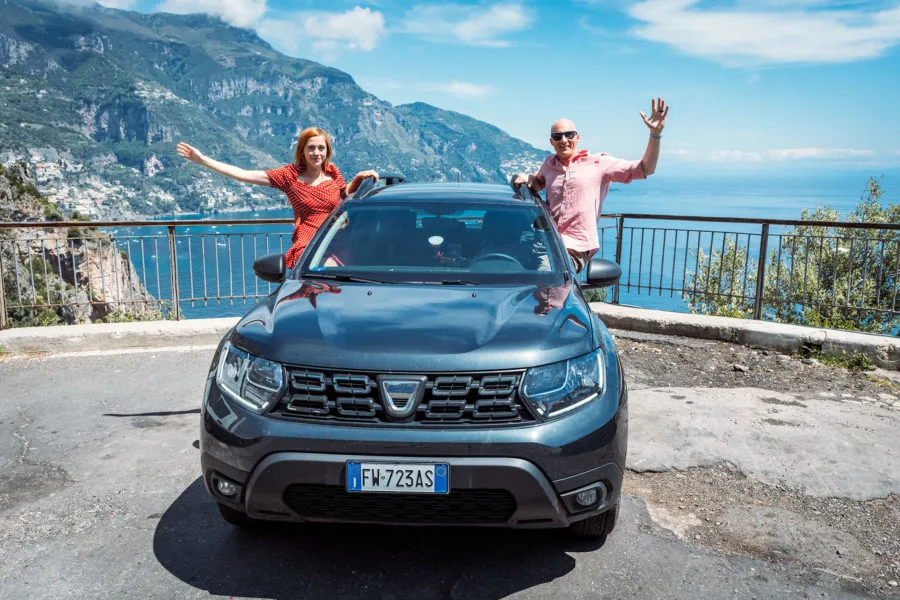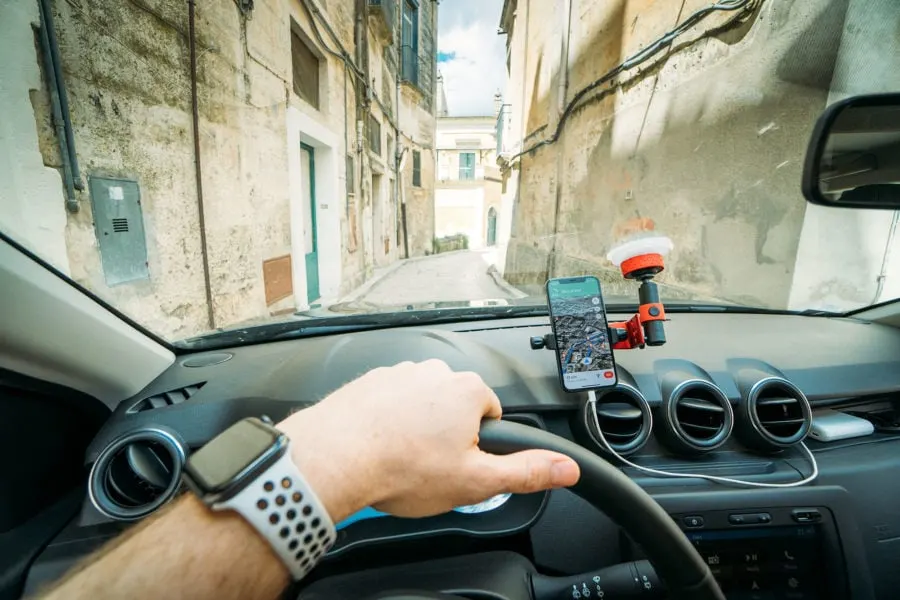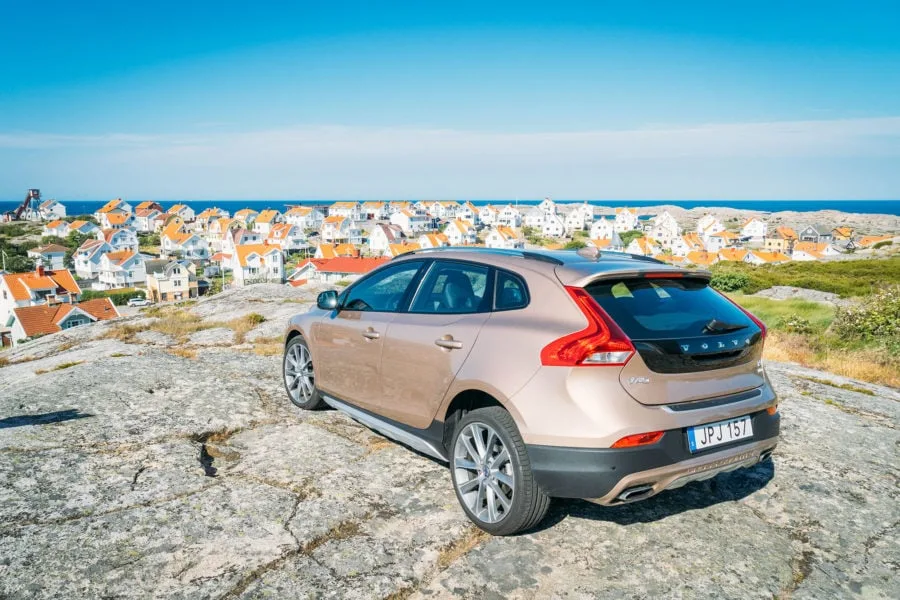
Europe Driving Guide
Renting a car in Europe and self-driving is a great way to experience the EU. But there are a few different things you should know before you embark on a European road trip.
My wife Anna and I spent a year living in Italy as expats without a car, preferring to rent cars when we wanted to go on a road trip, or for traveling to other European countries like France and Germany.
Over the years we’ve rented many cars in Europe on self-driving travel adventures through different European countries.
Some countries in Europe have a bit of a reputation for crazy driving (and drivers). I’m looking at you, Italy and Greece!
But we absolutely love the freedom of going on road trips and planning our own travel itineraries. Europe is such a diverse area of the world, that it made sense to rent a car so we could stop anywhere we liked — exploring local villages, mountains, and historic cities at our own pace.
Here are some important tips we learned from our MANY experiences renting a car in Europe, to help you save money and stay safe while driving here!
- How To Rent A Car In Europe: 2024 Guide
- 1. Should You Rent A Car In Europe?
- 2. Where To Rent Your Car In Europe
- 3. Car Rental Insurance In Europe
- 4. How Much Does It Cost To Rent A Car In Europe?
- 5. Rental Car Requirements In Europe
- 6. European Driving Laws Tourists Should Know
- 7. Extra Advice For Renting A Car In Europe
- 8. Accident & Breakdown Information
- Enjoy Your European Road Trip!

Hi, I’m Matthew Karsten
I’ve been traveling the world for 10+ years as a professional photographer & writer. I hope you enjoy my rental car tips! If you find them useful, using my affiliate links to book something will give me a small commission, at no extra cost to you. Thanks!
How To Rent A Car In Europe: 2024 Guide
1. Should You Rent A Car In Europe?

Hey, if you’re a fan of bus tours, by all means, go book one. It’s a decent way to see many countries in Europe if you don’t have a lot of time.
No planning, no driving, just sit back and let someone else do all the work!
But if you’re like me, you prefer the challenge of independent travel.
True adventure, with no set schedule or timetable. Driving around European destinations with the freedom to stop anywhere fun you happen to find along the way. Discovering places off-the-beaten path — that bus tours might miss.
If that’s the kind of traveler you are, renting a car in Europe is the way to go!
Sure, many parts of Europe have an excellent train system compared to the United States. But EuroRail passes can be surprisingly expensive, and they can also limit your options for where to travel.
Another nice thing about having a rental car was the ability to store luggage in the trunk, so you can explore cities with small travel backpacks rather than lugging a giant suitcase everywhere.
2. Where To Rent Your Car In Europe

The best site to book your car is Discover Cars. They search both local and international car rental companies to help you find the best possible price. This is the easiest way to rent a car in Europe.
They search for deals from popular European car rental companies like Avis, Hertz, EuropeCar, Sixt, Budget — as well as the lesser known local ones.
We’ve rented cars here in Italy, France, Iceland, Austria, Ireland, Scotland, Germany, Poland, Greece, Slovenia, Norway, and more.
Some of my favorite European drives so far include exploring the beautiful Amalfi Coast in Italy, and an epic photography road trip in Norway’s Lofoten Islands.

Rent A Car In Europe
Search both local and international car rental companies to help you find a good deal.
3. Car Rental Insurance In Europe

Some of the rumors about driving in Europe are true, and the roads can be VERY narrow. Especially the back roads outside smaller towns. And some countries have more aggressive drivers than others.
This is why I highly recommend getting full insurance coverage.
Typically, rental cars in Europe come with a basic Collision Damage Waiver (CDW), but this isn’t exactly insurance, and only covers the car for up to €1000-3000 EUROS worth of damage.
This is the amount they hold on your credit card until you return the car in one piece. CDW typically does not include tire, cracked windshield, or undercarriage damage either.
While you can often save money booking your car with a travel credit card that includes car rental insurance, you REALLY must read the fine print, because many people wrongly assume their card covers them everywhere.
If you get in a wreck driving in Europe, declined full coverage, and you suddenly learn your credit card doesn’t actually cover the damage — you’re screwed. I can’t tell you how many travel horror stories I’ve heard like this…
It’s why I usually pre-book full coverage online. It’s cheaper than at the counter — and then you won’t have to worry about accidents at all!
4. How Much Does It Cost To Rent A Car In Europe?

Renting a car in Europe is going to cost you around $30-$80 USD a day, depending on the type of car you get, and which country you rent it from. The typical compact 4-door sedan we usually rent averages about $40 per day.
I recommend renting a car with an actual trunk that can hide your luggage from prying eyes. It helps to prevent break-ins if thieves can’t see your stuff.
Gas Prices
Gas (petrol) prices in Europe might seem cheap to Americans, but remember that the rest of the world quotes gas in Liters, not Gallons (1 Gallon = 3.78 Liters).
Currently, gas costs about $7.14 per gallon (€1.55 per liter) in Portugal, $6.87 per gallon (€1.49 per liter) in Italy, and $5.93 per gallon (€1.29 per liter) in the UK. Diesel cars will often save you some money on gas.
Automatic vs Manual
Automatic cars are more expensive to rent than manual cars (but manuals are more common in Europe), and you must specify what type you want when booking.
If you’ve never driven a manual car before, don’t start in Europe! It’s safer to get an automatic, even if it costs more.
One-Way Rentals
There’s an additional fee for one-way car rentals in most European countries, which can vary by company. For example, if you want to drop off the rental car in a different city than where you started from.
These fees are even more expensive if you want to drop the car off in a different country — which can add a few hundred Euros to the price.
Admin & Credit Card Fees
If you opt to use your own credit card insurance, some companies in Europe will charge you an “admin fee” of about €20-€30 EURO. Other companies may charge a small fee for using a credit card.
Book In Advance
Your best bet is to book ahead if you want a good deal, particularly if you want to travel to popular destinations. Six months in advance seems to be the sweet spot for the best rates.
Many car rental companies offer free cancellation, so if your plans change you can always cancel down the road, without paying a fee. Just make sure to read the fine print.
Travel Off Season
Consider taking your European road trip during the shoulder tourist seasons, or off-season to get lower rental car rates.
Border Crossing Fee
When crossing the border from an EU country to a non-EU country by car, the rental agencies may charge a fee between €15 to €50. However there isn’t usually a fee for crossing from one EU country into another.
5. Rental Car Requirements In Europe

Each country has their own rules when it comes to driving. Canadians and Americans usually just need a driver’s license and passport to rent a car. However, some countries require an International Driving Permit (IDP).
Rules can change from place to place, but generally you’ll need an IDP if you plan to drive in the following countries: Austria, Bosnia-Herzegovina, Croatia, Greece, Hungary, Italy, Poland, Romania, Slovenia, Slovakia, or Spain.
You can get an IDP at the American Automobile Association or Canadian Automobile Association. Expect to pay about $20 plus the cost of two passport photos.
Age Requirements
Age requirements to rent a car in Europe vary. Travelers over the age of 25 shouldn’t have any issues. Younger drivers may have to pay a fee or purchase special insurance, which could cost between $15-$40 extra per day.
Keep in mind drivers over 70 years old may have trouble renting a car in countries like Czech Republic, Great Britain, Greece, Northern Ireland, Poland, Slovakia, Slovenia, and Turkey.
Drivers over 80 may have problems renting in Denmark. If you are over the age of 69, rental companies in Ireland might charge an extra fee.

Vignettes
In Europe, a vignette is a sticker placed on the windshield to indicate that you paid that country’s highway taxes. You can purchase one at a border crossing for €5 to €40, depending on the country. The vignette is usually good for a year.
Failure to buy a vignette could cost you a €60 fine or more. Border officials will often check for vignettes when you’re driving into or out of their country. Countries in Europe that require vignettes include Austria, Czech Republic, Slovakia, Romania, Switzerland, Hungary, Slovenia, and Bulgaria.
Sometimes, you may get lucky and your rental car will already have a vignette sticker on it. This is more common if you’re renting a car from a city that is close to the other country.
Crossing Borders
Some companies don’t allow drivers to drive to certain countries, usually in eastern or southeastern Europe. Common examples include Croatia, Serbia, Bosnia and Herzegovina, Albania, and Montenegro. Or, you may have to pay a fee for crossing those borders (mentioned earlier).
If you plan to drive in Ireland and Great Britain from Europe, you might want to book separately. Taking cars on ferries or the Eurotunnel car train can cost a lot. Plus, you’ll have to pay high surcharges and drop-off fees.
The Green Card
If you plan to cross borders, you may need a green card to prove that your car has the minimum level of insurance. Although you won’t need one for most countries in Europe, you will in places in the Balkan Peninsula, like Bosnia and Herzegovina, Albania, and Montenegro.
6. European Driving Laws Tourists Should Know

Right On Red Is Illegal
Unlike in the United States, it’s illegal to make a right turn on red lights in Europe, with some exceptions in Germany as indicated by traffic signs.
Learn European Street Signs
Street signs in Europe can differ greatly from your home country, and even between European countries. Before you start driving in Europe, research the meanings of different street signs for the countries you’re traveling to.
Passing Other Cars
In some countries (such as France, Germany, and the Netherlands), it’s illegal to use the slower lane (right lane) for passing other vehicles. Although in the United Kingdom and Ireland, remember that the lanes are opposite, and the passing lane is on the right side!
If you encounter a slow moving vehicle, and they have their blinker on, it might be an indication that they want you to pass them. This isn’t used consistently, but you may see it from time to time. Especially with large trucks or tractors (yes, tractors!)

Traffic Camera Speed Traps
Many European countries rely heavily on automatic traffic cameras to enforce their speed limits rather than using highway patrol officers, unlike the United States. When I first started driving in Europe, I got a few expensive speeding tickets not realizing this!
Usually the cameras are “announced” with a special sign, allowing you time to slow down right before them. But if you’re not looking for these signs, you could miss it, and end up with a ticket mailed to you after you return from your vacation!
Children’s Car Seat Requirements
If you’re driving in Europe with young kids, make sure to rent or bring your own child seat or booster seat. The EU requires children between the ages of 2 and 12 to use an appropriate restraint in cars. If you fly from the United States, FAA regulations allow passengers to bring a car seat onboard, an easy way to save money versus paying an extra daily fee on renting a car seat.
European car seat regulations are slightly different too, and if you’re using an American style car seat, and get pulled over, there is the potential to get a ticket. Although many tourists just take the risk.
Personally, we like to bring our own travel car seat that packs down super small for road trips overseas!
Learn About The Roundabout
Europeans love roundabouts. They’re much more common than the 4-way intersections found around the United States, and statistically much safer too. In a roundabout, traffic continually flows in a circle around a center island.
Don’t be scared of them, yield to other cars already inside, but keep up with the flow of traffic inside, and remember to signal when you want to exit the roundabout.
If you don’t know where to exit, just take another lap (or two) around the circle until you do. That’s perfectly ok.
As an American, I find it a bit difficult to speed-read all the road signs in the roundabout while also paying attention to traffic. It takes practice, but you’ll get the hang of it.
Zona Traffico Limitato (ZTL Zones)
In many historic cities around Europe, there are areas where tourists are not allowed to drive rental cars. In Italy they are called ZTL Zones (but each country may have a different term for them).
The streets in these areas are usually super narrow, and not equipped to handle tons of vehicle traffic. They are restricted to local residents with permits, or open only during certain times of day.
These special zones are covered with traffic cameras, and if you enter one at the wrong time, without a permit, you will automatically get a ticket sent to you — sometimes months later.
USEFUL TIP: Sometimes it’s just easier and cheaper to park your rental car on the outskirts of large European cities, and then take public transportation in.
7. Extra Advice For Renting A Car In Europe

- Parking can be a pain in European cities, as there usually isn’t a lot of space (if any at all). I recommend renting a compact car to make parking easier, and parking on the outskirts of large cities.
- Don’t book a car without reading company reviews. You’ll find plenty of bad reviews for every company (people love to complain online), but try to pick one with the LEAST bad reviews.
- You may not always get the make/model/type of car you booked. If they give you a smaller car, or a manual when you asked for an automatic, be pushy and ask for an upgrade.
- Inspect your car thoroughly and record video on your smartphone pointing out damage before you leave. This is a backup if they attempt to charge you for damage that was already there. This is a common travel scam in parts of Europe….
- Pay attention to if your rental car takes regular petrol or diesel fuel, so you fill up with the correct type at gas stations.
- Use Google Maps on your smartphone for directions. Bring your own hands-free adapter and buy a European SIM card for your phone at the airport. Just be aware that Google Maps isn’t always accurate either.
8. Accident & Breakdown Information
The European Emergency Phone Number is 112 (similar to 911 in the United States).
However if your car simply breaks down, and no one is injured, its probably better to call your car rental company’s own emergency roadside assistance number located on the rental agreement.
Enjoy Your European Road Trip!
Exploring the small villages, ancient castles, lush mountains, and coastal areas of Europe in a rental car was definitely the right choice for us.
Self-drive road trips allow you to get off the beaten track to see things most people miss! ★

Rent A Car In Europe
Search both local and international car rental companies to help you find a good deal.
| Travel Planning Resources For Europe |
|---|
| Packing Guide Check out my travel gear guide to help you start packing for your trip. Book Your Flight Ready to fly? Here’s how I find the cheapest airline flights. Rent A Car Discover Cars is a great site for comparing car prices to find a deal. Cheap Accommodation Learn how I save money booking hotels & vacation apartments. Protect Your Trip Don’t forget travel insurance! Protect yourself from possible injury & theft abroad. Read why you should always carry travel insurance. |
Enjoy This Article? Pin It!


READ MORE BUDGET TRAVEL TIPS
I hope you enjoyed my guide on renting cars in Europe! Hopefully you found it useful. Here are a few more wanderlust-inducing articles that I recommend you read next:
- Tips For Renting A Car In Ireland
- Advice For Driving In Iceland
- How To Rent A Gondola In Venice, Italy
- Top Things To Do In Dublin Ireland
- My Best Budget Travel Tips
Do you have any other suggestions or stories about renting cars in Europe? Join the conversation on Facebook, Instagram, or Twitter to share!
